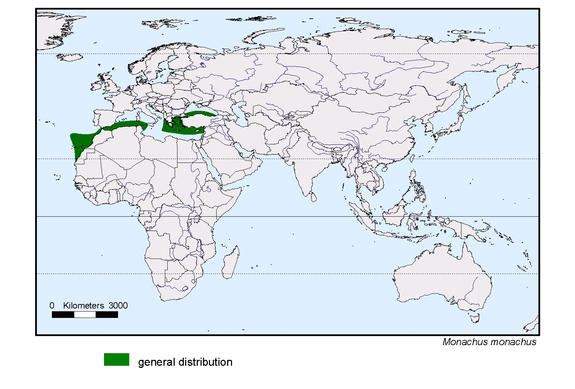
| Species fact sheet | by Global Register of Migratory Species - www.groms.de |
| Use the GROMS database for dynamic search for migratory species, new links and references. |
| Monachus monachus | (Hermann, 1779) |
| Synonym: | |
| Family: | Phocidae |
| Order: | Carnivora [Pinnipedia] |
| English: | Mediterranean monk seal |
| French: | Phoque moine de Méditerranée |
| Spanish: | Foca monje del Mediterráneo |
| German: | Mittelmeer-Mönchsrobbe (There's a German version of this page!) |
| Norwegian: | Middelhavs munkesel (There's a Norwegian version of this page!) |
| Migration: | range extension |
| Regions: | [...] |
| CMS: | App I & II |
| CITES: | I |
| RL1996: | CR |
| RL2000: | CR |
“The monk seal was once distributed throughout the Mediterranean, including the Black Sea and the North African Atlantic coast, as indicated by the general distribution outline (Ridgeway & Harrison 1981). This species was among the first species included in CMS Appendix I, because the "post breeding dispersal of young must regularly involve crossing of national frontiers" (BELF 1979). At that time, the population was estimated around 1,000 adult individuals.
With perhaps less than 400 of their number remaining and currently on the brink of extinction, the "Critically Endangered" (CR) Mediterranean monk seal is only found in remote and undisturbed areas, leading to a most severe contraction and fragmentation of its former range. The most important populations are located in Mauritania/Western Sahara, Greece and Turkey, while small numbers are also present in Morocco, Algeria, Libya, the Portuguese Desertas Islands (Madeira), Croatia and Cyprus. Note the difference between the general distribution map by Ridgeway & Harrison (1981), in contrast to the detailled account of present distribution given by Duguy & Robineau (1992). The largest colony is now found at Cap Blanc, Mauritania, but in 1998 more than half of the 300 individuals died in a mysterious disease outbreak (Osterhaus et. al. 1998). The remaining population of around 150 animals has not yet recovered, and it is now closely monitored by photoidentification of individuals (Samaranch & Gonzalez 2000). At Desertas Island, Madeira, the 14 to 18 remaining individuals are still endangered by entanglement in fishing gear and killing by fishermen, in spite of its strict protection by practically all national and international legal instruments (Neves 1998). A nature reserve was established by law on Desertas in May 1990. Besides habitat deterioration and overfishing, the species suffers particularly from human disturbance. Therefore, the few remaining individuals in touristic magnets such as Greece or Turkey are extremely threatened and require strict protection from tourist disturbance (Johnson & Lavigne 2001).”
, ():[...], p. [...]
| Further detailed information | from the GROMS database concerning Monachus monachus |
| More | about mammals general in: Riede, K. (2001): Global Register of Migratory Species. Weltregister wandernder Tierarten. (S. 55-69) |
| Recommended link(s): | (on the german or norwegian equivalent page regarding Monachus monachus there may be further links!) |
To gather more information about mammals in general see the link collection at connotea.org: mammalia
Please help us by updating our link collection via connotea!
Feedback: mail to: Klaus Riede
by Ansgar Tappenhölter